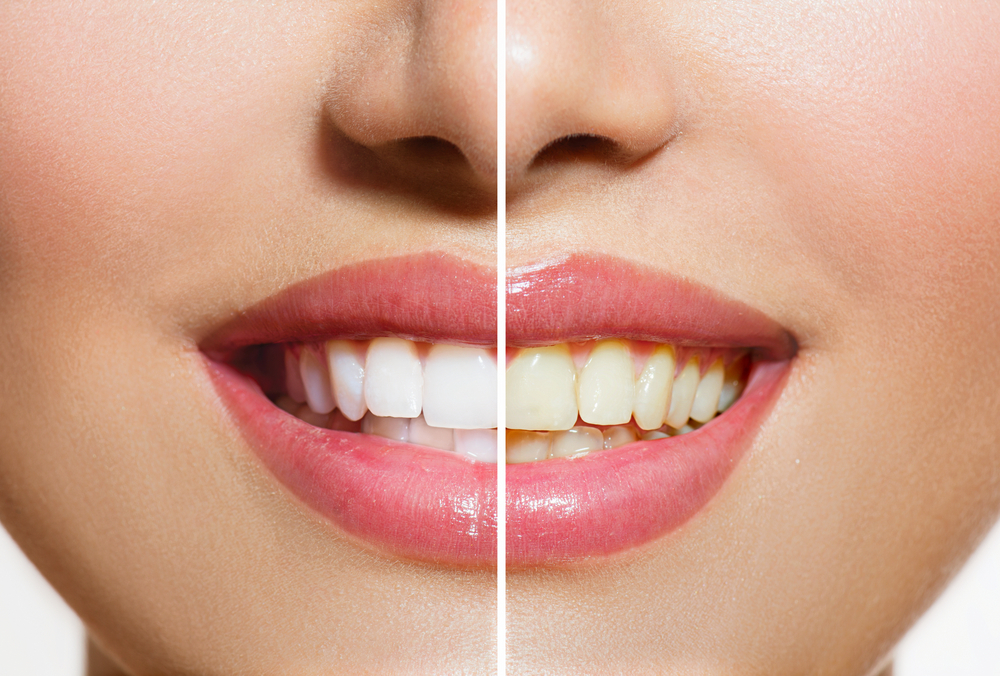Why Do Teeth Turn Yellow?

While celebrities and models may sport pearly white teeth, the smiles of most people are a tad duller. But this shouldn't be too surprising. Many things can affect the color of your teeth and turn them that dreaded yellow hue, which may make some people feel self-conscious about their appearance and hesitant to smile.
An abnormal tooth color is considered any color other than white or yellowish white, according to the U.S. National Library of Medicine.
Most causes of tooth discoloration fall into two main categories: extrinsic and intrinsic stains. Yellowing can also be caused by a wide array of health factors, from medication use to inadequate brushing.
Extrinsic stains
Extrinsic stains affect the surface of the enamel, which is the hard, outermost layer of teeth. Although tooth enamel can be easily stained, these stains can typically be removed or corrected.
"The No. 1 cause of teeth yellowing is lifestyle," said Dr. Justin Philipp of J. Philipp Dentistry in Chandler, Arizona. "Smoking, drinking coffees and teas, and chewing tobacco are the worst offenders."
The tar and nicotine in tobacco are chemicals that can cause yellowish stains on the surface of teeth, in people who smoke or chew.
As a rule of thumb, any food or drink that can stain clothes can also stain your teeth. So, that's why dark-colored foods and beverages, including red wine, colas, chocolate and dark sauces — such as soy sauce, balsamic vinegar, spaghetti sauce and curries — can discolor teeth. In addition, some fruits and vegetables — such as grapes, blueberries, cherries, beets and pomegranates — have the potential to stain teeth. These items are high in chromogens, pigment-producing substances that can stick to tooth enamel. Popsicles and candies are other foods likely to stain teeth.
Get the world’s most fascinating discoveries delivered straight to your inbox.
Acidic foods and beverages can promote staining by eroding tooth enamel and making it easier for pigments to latch onto the teeth. Tannin, a bitter compound found in wine and tea, also helps chromogens attach to tooth enamel, which ultimately causes staining. But there's good news for tea drinkers: A 2014 study published in the International Journal of Dental Hygiene found that adding milk to tea reduces its chances of staining teeth because the proteins in milk can bind to tannin.
Liquid forms of iron supplements can stain teeth, but there are several ways to prevent or remove these stains, according to the Mayo Clinic.
Not caring for teeth enough, such as inadequate brushing and flossing, and not going for regular dental cleanings can prevent the removal of stain-producing substances and lead to a buildup of plaque on teeth, resulting in discoloration.
Intrinsic stains
Intrinsic stains occur within the inner structure of the tooth, called the dentin, making these stains more difficult to remove.
Numerous medications can cause intrinsic stains on teeth. If children take the antibiotics tetracycline or doxycycline while their teeth are still developing (before the age of 8), their teeth may turn brownish-yellow. Women who take tetracycline after the fourth month of pregnancy or while breast-feeding, can cause a child to have discolored baby teeth, according to the Mayo Clinic.
During adulthood, using prescription-strength mouthwash containing chlorhexidine, a compound that can reduce bacteria and treat gingivitis (inflammation of the gums), can cause brown discolorations on teeth. In addition, the acne-fighting drug minocycline, a derivative of tetracycline, stains teeth.
Undergoing chemotherapy treatments as well as radiation to the head and neck can result in intrinsic stains. Even some relatively common drugs, such as antihistamines, antipsychotics and blood pressure medications can sometimes yellow teeth.
Although fluoride can be beneficial for teeth by strengthening the enamel and preventing decay, getting too much of the mineral is not good for your teeth color. Fluorosis, which results from excessive amounts of fluoride, may cause faint white streaks or brown spots on teeth. It is a problem mostly in areas where the drinking water contains high levels of naturally occurring fluoride, such as areas where people get their water from wells, according to Philipp. It's also possible to get too much fluoride from taking supplements or regularly using rinses and toothpastes with the mineral in it.
Dental treatments may also cause teeth to darken. "Many dental materials can cause discoloration, especially amalgam restorations (silver fillings)," said Dr. Bruno Sharp of Sharp Dentistry in Miami, Florida. These can give the tooth a gray-black tinge, according to The Cleveland Clinic.
Additional causes
Besides stains, some other causes of discolored teeth include genetics, age, illness and injuries.
There are many reasons why some people are more likely to have a yellow coloring to their teeth, said Dr. Edita Outericka, the dental director at Dynamic Dental in Mansfield, Massachusetts. "The No. 1 reason is genetics. Dentinogenesis imperfecta and amelogenesis imperfecta are two inherited disorders that cause the teeth to develop improperly and could lead to discoloration," Outericka explained.
Heredity is also the reason why some individuals have naturally brighter or thicker tooth enamel than others. You may simply be born with teeth that appear more yellow (or whiter) compared to other people's teeth, Outericka said. Part of this has to do with the thickness of your enamel, which is semi-translucent. If you have thin layer of enamel, the true color of your naturally yellowish dentin will show through.
Age can darken the color of your teeth: As you get older, the outer layer of enamel thins over time, making teeth appear more yellow. The best protection against thinning enamel is to ensure proper saliva production, which can wash away food and plaque from teeth, and getting enough fluoride, according to the Mayo Clinic. Brush twice a day with a fluoridated toothpaste, drink water treated with fluoride, and see a doctor if you are experiencing dry mouth to help prevent your tooth enamel from thinning.
The color of your teeth can also be affected by illness. Yellowing can occur after suffering a high fever at a young age due to an infection. Severe neonatal jaundice is another possible reason for teeth yellowing, according to Outericka.
Falls or sports injuries in young children can disturb the formation of tooth enamel when kids' permanent teeth are still developing, and can result in a grayish appearance. Similar injuries that damage the nerves or chip teeth in adults may also lead to a discoloration of permanent teeth. In addition, people who grind their teeth excessively, often while sleeping, may slowly remove the outer layer of tooth enamel exposing the yellowish dentin beneath it.
Prevention & treatment
The best prevention for yellow teeth is paying attention to what you eat and drink, and not smoking. You should also practice good dental hygiene and visit a dental professional at least twice a year.
The most easily repaired cause of yellowing teeth is poor oral hygiene: That's because when plaque (a film of bacteria that forms on teeth) and tarter (hardened dental plaque) build up, they can make teeth appear yellow. Removing that buildup before decay sets in is critical to having a whiter smile and healthy teeth, according to Outericka.
"It's best to have your teeth cleaned regularly by a professional " Outericka said. "This will help remove staining. Also, drinking through a straw will minimize the time that fluids stay on the surfaces of teeth," she noted. You can also rinse your mouth out with water after consuming foods or drinks that may stain, if brushing afterwards is not possible.
Should you not be happy with the color of your teeth, consult a dentist. "There are numerous treatments that can be performed which could lead to a bright white smile!", Outericka said.
Additional reporting by Cari Nierenberg and Joseph Castro, Live Science contributors.
Additional resources



